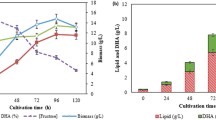Abstract
Optimization of medium components for enhancement of β-carotene production by Blakeslea trispora was achieved using mathematical statistics. Optimum concentrations of components using Plackett-Burman design and response surface methodology (RSM) were d-glucose 7.16%, wheat bran extract 4.08%, MgSO4 0.04%, soybean oil 3%, thiamine 0.01%, soybean meal 1%, and KH2PO4 0.2%. Maximum production of β-carotene using optimized medium was 643 mg/L in a shake flask. A predicted value of 669 mg/L was based on results of an RSM regression. The optimum aeration rate of 1.5 vvm produced 866 mg/L and the optimum agitation speed of 100 rpm produced 975 mg/L of β-carotene. The t of a quadratic model using regression derived coefficients was significant. Maximum production of β-carotene using the optimized medium in a stirred tank reactor (10 L) at an optimal aeration rate and an optimum agitation speed with addition of 0.1%(v/v) β-ionone was 1,357 mg/L.
Similar content being viewed by others
References
Paz ED, Ángel Martín, Estrella A. Soraya Rodríguez-Rojo, Matias A A. Formulation of β-carotene by precipitation from pressurized ethylacetate-on-water emulsions for application as natural colorant. Foodhyd. 26: 17–27 (2012)
Papaioannou EH, Stoforos NG, Liakopoulou-Kyriakides M. Substrate contribution on free radical scavenging capacity of carotenoid extracts produced from Blakeslea trispora cultures. World J. Microbiol. Biotechnol. 27: 851–858 (2011)
Kim JH, Kim SW, Nguyen DQA, Li He, Kim SB, Seo YG, Yang JK, Chung IY, Kim DH, Kim CJ. Production of β-carotene by recombinant E. coli with engineered whole mevalonate pathway in batch and fed-batch cultures. Biotechnol. Bioprocess Eng. 14: 559–564 (2009)
Li Z, Ma XQ, Li A, Zhang CW. A novel potential source of β-carotene: Eustigmatoscf polyphem (Eustigmatophyceae) and pilot β-carotene production in bubble column and flat panel photobioreactors. Bioresour. Technol. 117: 257–263 (2012).
Bhosale P. Environmental and cultural stimulants in the production of carotenoids from microorganisms. Appl. Microbiol. Biotechnol. 63: 351–361 (2004)
Cvetković D, Marković D. Beta-carotene suppression of benzophenone-sensitized lipid peroxidation in hexane through additional chain-breaking activities. Radiat. Phys. Chem. 80: 76–84 (2011)
Ribeiro BD, Barreto DW, Coelho MAZ. Technological aspects of acarotene production. Food Bioprocess Technol. 5: 693–701 (2011)
Lan CH, Fougère R, Waché Y. Increase in stability and change in supramolecular structure of β-carotene through encapsulation into polylactic acid nanoparticles. Food Chem. 124: 42–49 (2011)
Ribeiro BD, Coelho MAZ, Barreto DW. Production of concentrated natural beta-carotene from buriti (Mauritia vinifera) oil by enzymatic hydrolysis. Food Bioprod. Process 2: 141–147 (2011)
Mantzouridou F, Roukas T, Kotzekidou P. Effect of the areration rate and agitation speed on β-carotene production and morphology of Blakslea trispora in a stirred tank reactor:mathematical modeling. Biochem. Eng. J. 10: 123–135 (2002)
Varzakakou M, Roukas T, Kotzekidou P. Effect of the ratio of (+) and (-) mating type of Blakeslea trispora on carotene production from cheese whey in submerged fermentation. World J. Microbiol. Biotechnol. 12: 2151–2156 (2010)
Yan GL, Wen KR, Duan CQ. Enhancement of β-carotene production by over-expression of HMG-CoA reductase coupled with addition of ergosterol biosynthesis inhibitors in recombinant Saccharomyces cerevisiae. Curr. Microbiol. 64: 159–163 (2012)
Hanchinal VM, Survase SA, Sawant SK, Annapure US. Response surface methodology in media optimization for production of β-carotene from Daucus carota. Plant Cell Tiss. Organ. Cult. 93: 123–132 (2008)
Kuzina V, Ramírez-Medina H, Visser H, Cerdá-Olmedo E. Genes involved in carotenesynthesis and mating in Blakeslea trispora. Curr. Genet. 54: 143–152 (2008).
Mehta BJ, Obraztsova IN, Cerdá-Olmedo E. Mutants and intersexual heterokaryons of Blakeslea trispora for production of β-carotene and lycopene. Appl. Environ. Microbiol. 7: 4038–4043 (2003)
Roukas T, Niavi P, Kotzekidou P. A new medium for spore production of Blakeslea trispora using response surface methodology. World J. Microb. Biot. 27: 307–317 (2011)
Goksungur Y, Mantzouridou F, Roukas T, Kotzekidou P. Production of β-carotene from beet molasses by Blakeslea trispora in stirredtank and bubble column reactors. Appl. Biochem. Biotechnol. 112: 37–54 (2004)
Sheetal C, Singhal R. Media optimization for the production of β-carotene by Blakslea trispora: A statistical approach. Bioresour. Technol. 99: 722–730 (2008)
Mohammad R, Nasri N, Seyed Hadi R. Optimization of β-carotene production by a mutant of the lactose-positive yeast Rhodotorula acheniorum from whey ultrafiltrate. Food Sci. Biotechnol. 20: 445–454 (2011)
Mantzouridou F, Roukas T, Kotzekidoua P. Optimization of β-carotene production from synthetic medium by Blakeslea trispora a mathematical modeling. Appl. Biochem. Biotechnol. 101:153–175 (2002)
Xu F, Yuan QP, Zhu Y. Improved production of lycopene and β-carotene by Blakeslea trispora with oxygen-vectors. Process Biochem. 42: 289–293 (2007)
Nanou K, Roukas T, Kotzekidou P. Role of hydrolytic enzymes and oxidative stress in autolysis and morphology of Blakeslea trispora during β-carotene production in submerged fermentation. Appl. Microbiol. Biotechnol. 74: 447–453 (2007)
Mantzouridou F, Roukas T, Achatz B. Effect of oxygen transfer rate on β-carotene production from synthetic medium by Blakeslea trispora in shake flask culture. Enzyme Microb. Technol. 37: 687–694 (2005)
Sheetal MC, Ananthanarayan L, Rekha SS. Use of metabolic stimulators and inhibitors for enhanced production of β-carotene and lycopene by Blakeslea trispora NRRL 2895 and 2896. Bioresour. Technol. 99: 3166–3173 (2008)
Nanou K, Roukas T. Stimulation of the biosynthesis of carotenes by oxidative stress in Blakeslea trispora induced by elevated dissolved oxygen levels in the culture medium. Bioresour. Technol. 102: 8159–8164 (2011)
Nanou K, Roukas T, Papadakis E. Oxidative stress and morphological changes in Blakeslea trispora induced by enhanced aeration during carotene production in a bubble column reactor. Biochem. Eng. J. 54: 172–177 (2011)
Author information
Authors and Affiliations
Corresponding author
Rights and permissions
About this article
Cite this article
Yan, Z., Wang, C., Lin, J. et al. Medium optimization using mathematical statistics for production of β-Carotene by Blakeslea trispora and fermenting process regulation. Food Sci Biotechnol 22, 1667–1673 (2013). https://doi.org/10.1007/s10068-013-0265-8
Received:
Revised:
Accepted:
Published:
Issue Date:
DOI: https://doi.org/10.1007/s10068-013-0265-8




